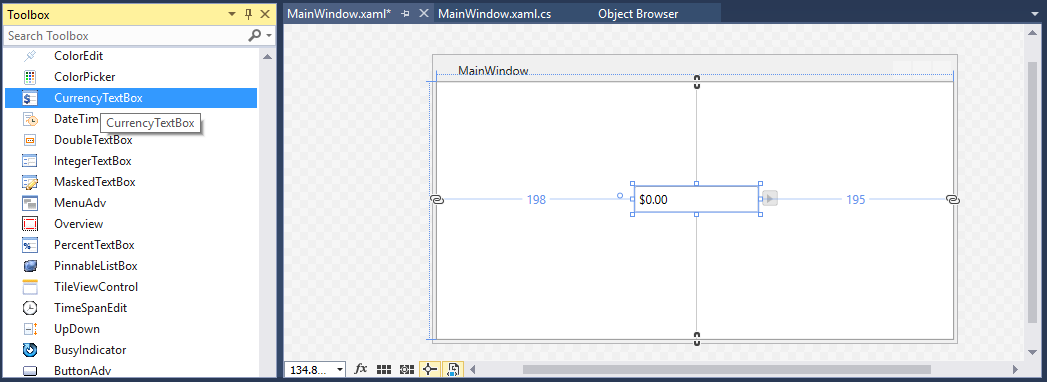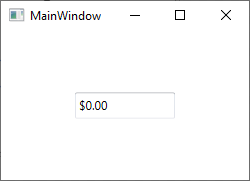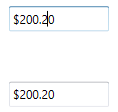Getting Started with WPF Currency TextBox
18 Feb 20259 minutes to read
This section explains how to create a WPF CurrencyTextBox control and its features.
Assembly deployment
Refer to the control dependencies section to get the list of assemblies or NuGet package that needs to be added as a reference to use the control in any application.
You can find more details about installing the NuGet package in a WPF application in the following link:
Adding WPF CurrencyTextBox via designer
You can add the CurrencyTextBox control to an application by dragging it from the toolbox to a view of the designer. The following dependent assembly will be added automatically:
- Syncfusion.Shared.WPF

Adding WPF CurrencyTextBox via XAML
To add the CurrencyTextBox control manually in XAML, follow these steps:
-
Create a new WPF project in Visual Studio.
-
Add the Syncfusion.Shared.WPF assembly references to the project.
-
Import Syncfusion® WPF schema http://schemas.syncfusion.com/wpf and declare the
CurrencyTextBoxcontrol in XAML page.<Window xmlns="http://schemas.microsoft.com/winfx/2006/xaml/presentation" xmlns:x="http://schemas.microsoft.com/winfx/2006/xaml" xmlns:syncfusion="http://schemas.syncfusion.com/wpf" x:Class="CurrencyTextBoxSample.MainWindow" Title="CurrencyTextBox Sample" Height="350" Width="525"> <Grid> <!--Adding CurrencyTextBox control --> <syncfusion:CurrencyTextBox x:Name="currencyTextBox" Width="100" Height="25" VerticalAlignment="Center" HorizontalAlignment="Center"/> </Grid> </Window>
Adding WPF CurrencyTextBox via C#
To add the CurrencyTextBox control manually in C#, follow these steps:
-
Create a new WPF application via Visual Studio.
-
Add the Syncfusion.Shared.WPF assembly references to the project.
-
Include the required namespace.
using Syncfusion.Windows.Shared; -
Create an instance of CurrencyTextBox and add it to the window.
//Creating an instance of CurrencyTextBox control CurrencyTextBox currencyTextBox = new CurrencyTextBox(); // Setting height and width to CurrencyTextBox currencyTextBox.Height = 25; currencyTextBox.Width = 100; //Adding CurrencyTextBox as window content this.Content = currencyTextBox;

Setting Value
The value of the CurrencyTextBox can be set by using the Value property.
<syncfusion:CurrencyTextBox x:Name="currencyTextBox" Width="100" Height="23" Value="100"/>CurrencyTextBox currencyTextBox = new CurrencyTextBox();
currencyTextBox.Width = 100;
currencyTextBox.Height = 23;
currencyTextBox.Value = 100;
NOTE
Do not use the Text property to set the value for the CurrencyTextBox. Use only the
Valueproperty.
Binding Value
Data binding is the method of forming a connection between the application UI and business logic. Data binding can be unidirectional (source -> target or target <- source) or bidirectional (source <-> target). You can bind data to the CurrencyTextBox using the Value Property.
The following code snippets illustrate the value binding from one CurrencyTextBox to another.
<StackPanel>
<syncfusion:CurrencyTextBox x:Name="currencyTextBox1" Height="25" Width="100" Value="{Binding MyValue,UpdateSourceTrigger=PropertyChanged}"/>
<syncfusion:CurrencyTextBox x:Name="currencyTextBox2" Width="100" Height="25" Value="{Binding MyValue,UpdateSourceTrigger=PropertyChanged}" />
</StackPanel>ViewModel.cs
class ViewModel : NotificationObject
{
private double myValue;
public double MyValue
{
get
{
return myValue;
}
set
{
myValue = value;
RaisePropertyChanged("MyValue");
}
}
}
Value Changed Notification
The CurrencyTextBox control can notifies the value changes through the ValueChanged event. You can get old value and new Value from OldValue and NewValue properties in ValueChanged event.
<syncfusion:CurrencyTextBox ValueChanged="CurrencyTextBox_ValueChanged"/>CurrencyTextBox currencyTextBox = new CurrencyTextBox();
currencyTextBox.ValueChanged += new PropertyChangedCallback(CurrencyTextBox_ValueChanged);You can handle the event as follows:
private void CurrencyTextBox_ValueChanged(DependencyObject d, DependencyPropertyChangedEventArgs e)
{
// Get old and new value
var newValue = e.NewValue;
var oldValue = e.OldValue;
}Min Max Value Restriction
The Value of CurrencyTextBox can be restricted within maximum and minimum limit. You can define the minimum and maximum values by setting the MinValue and MaxValue properties. It allows the user to enter the value between MinValue and MaxValue.
<syncfusion:CurrencyTextBox x:Name="currencyTextBox" Width="100" Height="25" Value="455" MaxValue="999.99" MinValue="-999.99"/>CurrencyTextBox currencyTextBox = new CurrencyTextBox();
currencyTextBox.Width = 100;
currencyTextBox.Height = 25;
//Setting minimum value
currencyTextBox.MinValue = -999.99;
//Setting maximum value
currencyTextBox.MaxValue = 999.99;
currencyTextBox.Value = 455;
Step Interval to increase or decrease the value
The CurrencyTextBox control allows to increase or decrease the value by pressing up and down arrow keys in keyboard or mouse wheel over the control. The ScrollInterval property is used to specify the increment or decrement intervals. The default value of ScrollInterval is 1.
<syncfusion:CurrencyTextBox x:Name="currencyTextBox" Width="100" Height="25" Value="8"
IsScrollingOnCircle="True" ScrollInterval="4"/>CurrencyTextBox currencyTextBox = new CurrencyTextBox();
currencyTextBox.Width = 100;
currencyTextBox.Height = 25;
currencyTextBox.MinValue = 0;
currencyTextBox.MaxValue = 100;
currencyTextBox.Value = 8;
currencyTextBox.IsScrollingOnCircle = true;
currencyTextBox.ScrollInterval = 4;
Formatting the value
You can customize the number format by using either the NumberFormat property or the CurrencyGroupSeparator, CurrencyGroupSizes, CurrencyDecimalDigits and CurrencyDecimalSeparator, CurrencySymbol, CurrencyNegativePattern, and CurrencyPositivePattern properties of CurrencyTextBox.
<syncfusion:CurrencyTextBox x:Name="currencyTextBox" Height="25" Width="150" Value="1234567">
<syncfusion:CurrencyTextBox.NumberFormat >
<numberformat:NumberFormatInfo CurrencyGroupSeparator="/" CurrencyDecimalDigits="4" CurrencyDecimalSeparator="*" CurrencySymbol="$"/>
</syncfusion:CurrencyTextBox.NumberFormat>
</syncfusion:CurrencyTextBox>CurrencyTextBox currencyTextBox = new CurrencyTextBox();
currencyTextBox.Width = 100;
currencyTextBox.Height = 25;
currencyTextBox.Value = 1234567;
currencyTextBox.NumberFormat = new NumberFormatInfo()
{
CurrencyGroupSeparator = "/",
CurrencyDecimalDigits = 4,
CurrencyDecimalSeparator = "*",
CurrencySymbol = "$"
};
Setting the Culture
The CurrencyTextBox provides support for globalization by using the Culture property. The Culture is used to format the decimal separator and group separator of the CurrencyTextBox value based on the respective culture.
<syncfusion:CurrencyTextBox x:Name="currencyTextBox" Height="25" Width="100" Culture="en-US" Value="1234567"/>CurrencyTextBox currencyTextBox = new CurrencyTextBox();
currencyTextBox.Width = 100;
currencyTextBox.Height = 25;
currencyTextBox.Value = 1234567;
currencyTextBox.Culture = new System.Globalization.CultureInfo("en-US");
NOTE
When you use both
NumberFormatandCulture, theNumberFormatwill have a higher priority.
Theme
CurrencyTextBox supports various built-in themes. Refer to the below links to apply themes for the CurrencyTextBox,
